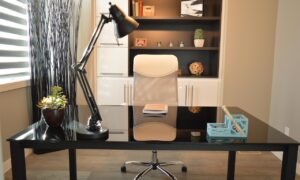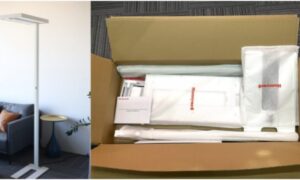Having a comfortable, safe home office is often a decision between fact and fiction. Let’s dispel some myths.
Relegated to a home office, it’s time to get comfortable
Now that the majority of us are commuting to our spare bedroom for another fun-filled day of work, we get to design our workspace completely. We are no longer sharing a cloth-covered cubicle wall with the guy from IT, no more dirty dishes left by others, and no more industrial desk and chair. Now we have options.
Standing desks
Advertisements for standing desks have claimed the simple act of getting out of your chair will burn 40% more calories than sitting hunched over the keyboard. It’s a compelling story. So much so Facebook and Google bought into and provided standing desks for their employees.
Standing, though, isn’t without drawbacks. Spending 10 hours a day on one’s feet in anyplace other than a tradeshow floor seems, well, seems wrong. Any waitress can tell you this is a sure-fire path to varicose veins and constricted arteries.
On the positive side, many people report arm and wrist pain was diminished or alleviated when they switched a standing desk. Some have said standing desks cause back pain. The majority agree the key is moderation.
Don’t buy a standing desk and expect to begin standing for eight to ten hours a day immediately. Instead, try standing in the mornings or every other day. Break it up and let your body become acclimated.
Whether you choose to stand or sit, it’s moving once an hour that can make the most significant difference. Anyone with an Apple Watch knows this because there’s a handy alarm that reminds them to get up, or if already standing, get moving. Make coffee, get the mail, pet the dog, pick up the kids. Whatever it takes, just move.
Exercise ball as a chair
Those advertisers are at it again. They would have us believe using an exercise ball as, and office chair will reduce fatigue and discomfort, but is it true?
The idea of sitting on an unstable ball is that the sitter will increase his or her trunk muscles through constant activation while trying to balance. Ideally, this will increase one’s core strength, improve posture, and decrease the discomfort of sitting on a hard surface all day. Like standing desks, there are claims of additional calorie burn as well.
So what do the experts say? The bulk of research on this topic shows that people are accumulating problems more than they are burning calories. In a study published on Sage Journals, the authors found, “Prolonged sitting on a stability ball does not greatly alter the manner in which an individual sits, yet it appears to increase the level of discomfort.”
Another study published on ScienceDirect found, “There was no difference in muscle activation profiles of each of the 14 muscles between sitting on the stool and ball. Calculated stability and compression values showed sitting on the ball made no difference in mean response values. The contact area of the seat-user interface was greatest on the exercise ball.”
That sounds like a no.
Computers on or off?
Should you shut off the monitor as protection from hacking attacks, prevent wearing out the on/off button, or keep your screen from burning out? Probably not. Here’s why.
While you are away from your computer, there are processes to run, such as software and firmware updates—not to mention all the software updates just waiting for a break in the activity. If using an automated online backup process (doesn’t everyone?), that process needs to run as well. All of this can be inconvenient if it runs in the middle of the workday and slows your computer.
Leaving the computer on all the time is convenient and, according to some, it prolongs the usable life. It also generates heat that can reduce electricity demands by replacing the amount of heat needed to warm a cold house.
Conversely, turning your computer off reduces the amount of electricity used, extends the usable life (according to others), reduces ambient noise, and reduces heat output. This excess warmth is unwelcome by people in warm climes that use air conditioning.
If the computer is always on, restart it every couple of days to free up the memory, which may be caching information you no longer need. You might find it more convenient to restart at night so it will be up and running for the morning.
If the computer is a laptop, keep it on a cooling pad. These portable computers run hotter because the components are crammed together in a small case.
In summary
Everyone has an opinion and it’s rare when they all agree. Deciding whether to stand, sit on a ball, or turn off your computer is, in the end, a personal decision. We all want our life to be more convenient and to reduce risk. Working from home seems to be here to stay, at least for the foreseeable future, so spend some time trying new things to figure out what works best for you.



































